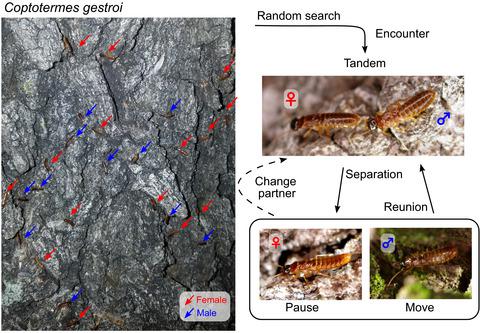当前位置:
X-MOL 学术
›
J. Anim. Ecol.
›
论文详情
Our official English website, www.x-mol.net, welcomes your
feedback! (Note: you will need to create a separate account there.)
Termite males enhance mating encounters by changing speed according to density
Journal of Animal Ecology ( IF 3.5 ) Pub Date : 2020-09-20 , DOI: 10.1111/1365-2656.13320 Nobuaki Mizumoto 1, 2 , Arturo Rizo 1 , Stephen C Pratt 1 , Thomas Chouvenc 3
Journal of Animal Ecology ( IF 3.5 ) Pub Date : 2020-09-20 , DOI: 10.1111/1365-2656.13320 Nobuaki Mizumoto 1, 2 , Arturo Rizo 1 , Stephen C Pratt 1 , Thomas Chouvenc 3
Affiliation

|
Search theory predicts that animals evolve efficient movement patterns to enhance encounter rates with specific targets. The optimal movements vary with the surrounding environments, which may explain the observation that animals often switch their movement patterns depending on conditions. However, the effectiveness of behavioral change during search is rarely evaluated because it is difficult to examine the actual encounter dynamics. Here we studied how partner-seeking termites update their search strategies depending on the local densities of potential mates. After a dispersal flight, termites drop their wings and walk to search for a mate; when a female and a male meet, they form a female-led tandem pair and search for a favorable nesting site. If a pair is separated, they have two search options: reunite with their stray partner, or seek a new partner. We hypothesized that the density of individuals affects separation-reunion dynamics and thus the optimal search strategy. We observed the searching process across different densities and found that termite pairs were often separated but obtained a new partner quickly at high mate density. After separation, while females consistently slowed down, males increased their speed according to the density. Under high mate density, separated males obtained a partner earlier than females, who do not change movement with density. Our data-based simulations confirmed that the observed behavioral change by males contributes to enhancing encounters. Males at very low mate densities did best to move slowly and thereby reduce the risk of missing their stray partner, who is the only available mate. On the other hand, males that experienced high mate densities did better in mating encounters by moving fast because the risk of isolation is low, and they must compete with other males to find a partner. These results demonstrate that termite males adaptively update their search strategy depending on conditions. Understanding the encounter dynamics experienced by animals is key to connecting empirical work to the idealized search processes of theoretical studies.
中文翻译:

白蚁雄性通过根据密度改变速度来增强交配机会
搜索理论预测,动物会进化出有效的运动模式,以提高与特定目标的遭遇率。最佳运动因周围环境而异,这可以解释动物经常根据条件切换运动模式的观察结果。然而,搜索过程中行为改变的有效性很少被评估,因为很难检查实际的遭遇动态。在这里,我们研究了寻找伴侣的白蚁如何根据潜在伴侣的本地密度更新其搜索策略。飞散后,白蚁放下翅膀,步行寻找配偶;当雌性和雄性相遇时,它们会形成雌性主导的串联配对并寻找有利的筑巢地点。如果一对分开,他们有两个搜索选项:与他们的流浪伴侣重聚,或寻找新的合作伙伴。我们假设个体的密度会影响分离-团聚动态,从而影响最佳搜索策略。我们观察了不同密度下的搜索过程,发现白蚁对经常被分离,但在高配偶密度下迅速获得新伙伴。分离后,虽然雌性一直放慢速度,但雄性会根据密度增加速度。在高配偶密度下,分离的雄性比雌性更早获得伴侣,雌性不随密度改变运动。我们基于数据的模拟证实,观察到的男性行为变化有助于增强相遇。配偶密度非常低的雄性最好缓慢移动,从而降低失去流浪伴侣的风险,后者是唯一可用的配偶。另一方面,经历过高配偶密度的雄性通过快速移动在交配中表现得更好,因为孤立的风险很低,而且它们必须与其他雄性竞争才能找到伴侣。这些结果表明,白蚁雄性会根据条件自适应地更新其搜索策略。了解动物所经历的遭遇动态是将实证工作与理论研究的理想化搜索过程联系起来的关键。
更新日期:2020-09-20
中文翻译:

白蚁雄性通过根据密度改变速度来增强交配机会
搜索理论预测,动物会进化出有效的运动模式,以提高与特定目标的遭遇率。最佳运动因周围环境而异,这可以解释动物经常根据条件切换运动模式的观察结果。然而,搜索过程中行为改变的有效性很少被评估,因为很难检查实际的遭遇动态。在这里,我们研究了寻找伴侣的白蚁如何根据潜在伴侣的本地密度更新其搜索策略。飞散后,白蚁放下翅膀,步行寻找配偶;当雌性和雄性相遇时,它们会形成雌性主导的串联配对并寻找有利的筑巢地点。如果一对分开,他们有两个搜索选项:与他们的流浪伴侣重聚,或寻找新的合作伙伴。我们假设个体的密度会影响分离-团聚动态,从而影响最佳搜索策略。我们观察了不同密度下的搜索过程,发现白蚁对经常被分离,但在高配偶密度下迅速获得新伙伴。分离后,虽然雌性一直放慢速度,但雄性会根据密度增加速度。在高配偶密度下,分离的雄性比雌性更早获得伴侣,雌性不随密度改变运动。我们基于数据的模拟证实,观察到的男性行为变化有助于增强相遇。配偶密度非常低的雄性最好缓慢移动,从而降低失去流浪伴侣的风险,后者是唯一可用的配偶。另一方面,经历过高配偶密度的雄性通过快速移动在交配中表现得更好,因为孤立的风险很低,而且它们必须与其他雄性竞争才能找到伴侣。这些结果表明,白蚁雄性会根据条件自适应地更新其搜索策略。了解动物所经历的遭遇动态是将实证工作与理论研究的理想化搜索过程联系起来的关键。











































 京公网安备 11010802027423号
京公网安备 11010802027423号